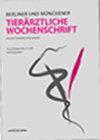Authorization of animal research proposals – a comparison of harm concepts in different European regulations
IF 0.6
4区 农林科学
Q4 VETERINARY SCIENCES
Berliner und Munchener tierarztliche Wochenschrift
Pub Date : 2020-01-01
DOI:10.2376/0005-9366-19057
引用次数: 2
Abstract
Meeting the professional responsibilities of veterinarians in animal research has been described by the German Federal Chamber of Veterinary Surgeons (Bundestierarztekammer, BTK) as a “special ethical challenge”. Veterinarians are involved in animal research, not only as researcher and animal welfare officers, but also as members of ethical review committees and as such require a unique set of skills to provide a wide range of services and practices. Animal research in Europe is strictly regulated. The harm-benefit analysis (HBA) is one of the legal corner stones in project authorization and as such has to be carried out within a specific legal framework. Hence, veterinarians (and other members of ethical review committees) require an understanding of the normative foundation of animal research legislation in order to fulfill their role and responsibilities. Against this background, it is the goal of this article (1) to introduce the rationale and role of the harm concept and the HBA in project evaluation of animal research. (2) We then outline the different harm concepts which the European and the Swiss legislation are based on and (3) elaborate on the moral significance that is given to different forms of harm within the HBA in these legal frameworks. (4) Last, we demonstrate potential practical implications of these conceptually different normative frameworks for project evaluation in animal research with the practical example of genetically disenhancing the ability of rodents to feel pain and to suffer.动物研究提案的授权-不同欧洲法规中危害概念的比较
德国联邦兽医协会(bundesestierarztekammer, BTK)将履行兽医在动物研究中的专业责任描述为一项“特殊的道德挑战”。兽医参与动物研究,不仅作为研究人员和动物福利官员,而且作为伦理审查委员会的成员,因此需要一套独特的技能来提供广泛的服务和实践。在欧洲,动物研究受到严格监管。损益分析(HBA)是项目授权的法律基石之一,因此必须在特定的法律框架内进行。因此,兽医(和伦理审查委员会的其他成员)需要了解动物研究立法的规范基础,以履行他们的角色和责任。在此背景下,本文的目的(1)是介绍危害概念和HBA在动物研究项目评估中的基本原理和作用。(2)然后,我们概述了欧洲和瑞士立法所基于的不同伤害概念;(3)详细阐述了在这些法律框架中,HBA中不同形式的伤害所具有的道德意义。(4)最后,我们以基因抑制啮齿动物感知疼痛和遭受痛苦的能力为例,论证了这些概念上不同的规范框架在动物研究项目评估中的潜在实际意义。
本文章由计算机程序翻译,如有差异,请以英文原文为准。
求助全文
约1分钟内获得全文
求助全文
来源期刊
CiteScore
0.90
自引率
0.00%
发文量
0
审稿时长
18-36 weeks
期刊介绍:
The Berliner und Münchener Tierärztliche Wochenschrift is an open access, peer-reviewed journal that publishes contributions on all aspects of veterinary public health and its related subjects, such as epidemiology, bacteriology, virology, pathology, immunology, parasitology, and mycology. The journal publishes original research papers, review articles, case studies and short communications on farm animals, companion animals, equines, wild animals and laboratory animals. In addition, the editors regularly commission special issues on topics of major importance. The journal’s articles are published either in German or English and always include an abstract in the other language.

 求助内容:
求助内容: 应助结果提醒方式:
应助结果提醒方式:


